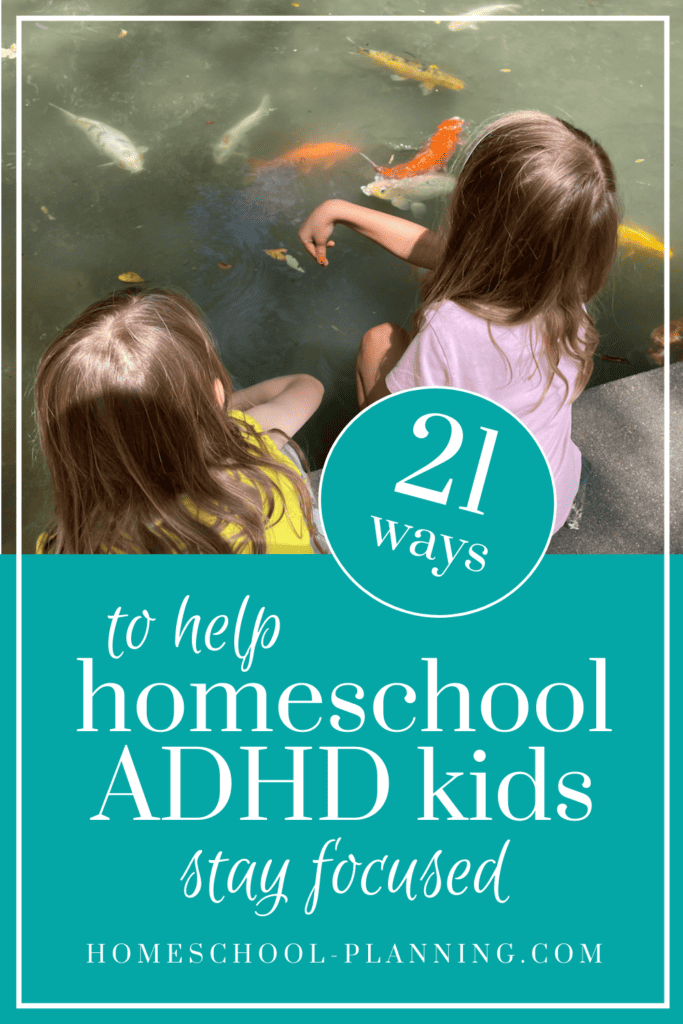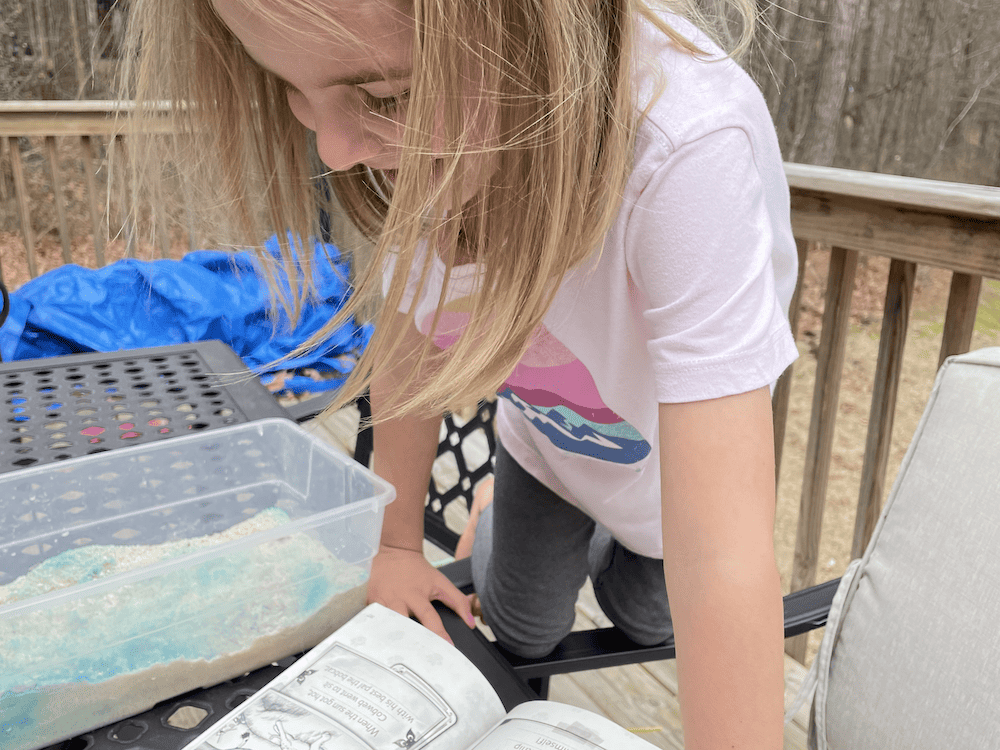Homeschooling a child with ADHD requires a unique approach that helps them with their special needs and challenges. Children often struggle with staying focused. But with the right strategies, you can create an effective and supportive learning environment.
While this may be written for kids with ADHD, you could easily apply these strategies to any homeschool student with focus issues. Especially those active boys!
Have the right expectations
It’s tempting to look at our kids and think they should be able to sit still for hours and do everything we ask of them. But remember that they are not little adults. Kids have much shorter attention spans and will often have a hard time sitting still for longer than a few minutes. Especially young boys!
THIS IS NORMAL!
Wanting to move around does not necessarily mean they have anything wrong with them or need a diagnosis of some sort. We just need to adjust our expectations.
There are many ways you can set up your homeschool to work for your child rather than trying to fit your child into an abstract idea of what a homeschool should look like!
Keep reading for ideas!

How to help your ADHD homeschooler stay focused
Here are 21 ideas to help homeschooling ADHD kids stay focused.
1. Do schoolwork together
Sometimes, ADHD children benefit from having someone do schoolwork with them. Sit down with your child and work on schoolwork together. This can help them feel a little more structure and accountability, feel less alone, and make learning more fun. It can also help them stay on track and deal with problems as they come to them.
2. Use visual schedules
Children with ADHD often do well when they can see their schedule. Create a visual schedule or checklist that outlines the day’s tasks and activities. This can help your child understand what to expect and give them an idea of what comes next. You can even allow them to check off completed tasks, which can help them feel more accomplished, being able to stay focused for the next task at hand.

3. Give lots of breaks
Children with ADHD often have high levels of energy, which can make it hard for them to sit still and focus for long amounts of time. Giving them frequent, short breaks helps them to release that energy so they can focus again. You might let them run around for a bit, do some physical exercises, or just play for a few minutes.
If it seems they’ve hit a wall in their learning, it’s okay to stop for the day. The schoolwork will still be there tomorrow.
4. Listen to music
Some homeschoolers with ADHD may notice that listening to soft, non-distracting background music can help them concentrate better on their schoolwork. Music can reduce distractions around them that might make them lose focus. Often classical music is great but any music without words may work for your child.
5. Use background noise
In addition to music, consider using some background sounds like white noise, rain, or other ambient sounds to create a less distracting area. White noise can help drown out sudden or distracting sounds, making it easier to concentrate on schoolwork and other tasks. You can use a loud fan or apps specifically designed for making background noise. Iphones now have this function built in!

6. Back up and review
ADHD homeschoolers may benefit from backing up and going over material they have already learned to reinforce their understanding and build confidence. Occasional review can help them retain information and build a better foundation for new ideas. This can also help lower frustration with new or challenging concepts.
If you run into a topic that seems to be challenging for your child, sometimes all that is needed is to stop, back up, and review easier topics. You may even need to set it aside for a bit. After some days or even weeks, come back to the lesson and it may seem like the fog has lifted and they can easily tackle the work.
7. Skip ahead
Encourage homeschool ADHD kids to explore more difficult work if they find the current topics too easy or uninteresting. There’s nothing wrong with letting a child skip ahead to help them stay engaged and motivated. Just be sure they are progressing well and understanding foundational concepts before they move forward.
8. Use short lessons
ADHD homeschoolers often work better with shorter lessons. This helps them not tire too easily and may allow them to stay focused for multiple subjects. Aim for quality over quantity and be sure each lesson is at an achievable level for them to conquer – at or just above their current knowledge.
If it seems they’ve hit a wall in a lesson, it’s okay to stop for the day. The schoolwork will still be there tomorrow.

9. Don’t sit at desks
Give your homeschool ADHD children space to allow them to move around while they do their schoolwork. Not all learning has to happen at a traditional desk or table. Let your kids choose where they’d like to do schoolwork, whether it’s sitting on the floor, going outdoors, sitting on the couch with a clipboard, or in a cozy reading nook. This freedom of movement can help them stay engaged.
10. Move faster through lessons
Flexibility is important when homeschooling ADHD children. Adjust the pace of lessons to match your child’s attention span and learning speed. Some may require a quicker progression through lessons to prevent boredom and restlessness, while others may need more time to digest information fully.
11. Remove busywork
Streamline lessons by removing unnecessary assignments or activities. ADHD children may find busywork frustrating, as it doesn’t really help their learning. Focus on meaningful tasks that reinforce main concepts and skills. Not every child will like crafts or crossword puzzles, and not every child will be a great writer.
While it’s good to encourage kids to do things they don’t enjoy occasionally, too many “reinforcement activities” can be useless and just frustrate kids. Especially kids who already have trouble focusing.

12. Don’t do all the problems in a lesson
Prioritize mastery over amounts when assigning problems or exercises. ADHD homeschoolers may struggle with holding attention when practicing large amounts of problems. Instead, choose a manageable number of problems that allow them to practice without being overwhelmed.
13. Don’t put everything in front of them at once
ADHD children can become easily overwhelmed when presented with too much information at once. To prevent information overload, teach new concepts one step at a time. This will help them grasp and learn more effectively.
In the same way, don’t show kids the whole day’s lessons at once. Laying out the lessons at once for all subjects and for the whole day may overwhelm the student. instead, show them one subject, and once that has been finished, pull out the next, and so on. What may not seem like much to you can overwhelm a child.
14. Change how you learn (use a different learning style)
ADHD children learn in various ways. Explore various teaching methods and adapt to your child’s preferred learning style. For example, some children may excel with pictures and reading, while others may benefit from hands-on activities or interactive discussions. Tailoring your approach to their style can improve engagement and focus.
Read: How audiobooks can benefit your homeschool and where to find them!
Better yet, use multiple styles of learning for every lesson to give multiple ways to soak up the information.

15. Make it more fun
Engage your homeschool ADHD child by incorporating some fun into your lessons. Games, interactive activities, and real-world experiences can make learning more enjoyable. When children are having fun, they are more likely to stay focused and absorb information.
But remember that not all learning is easy or fun, and we must still do the hard work needed. A good balance in your homeschool can go a long way toward an amazing education.
Online apps and games are great to use as supplement or use an online curriculum for a different spin! Check out this post on online homeschooling for ideas!
16. Switch curriculum
If your current curriculum isn’t working for your ADHD child, be open to switching to one that works better. Every curriculum is different and will offer its own spin on a subject. It’s okay to test out several options before committing to a set for the whole year. In fact, many companies offer free trials for just this reason!
17. Monitor screen time
Be mindful of screen time and its potential impact on focus and attention. A lot of games and TV is not good for the developing mind and can negatively impact a child’s ability to focus. Set limits on recreational screen time and be sure that educational screen time is used well for learning.

18. Give space to learn
Create a good space that encourages learning and exploring. Provide books, time, and tools they can use to learn new things. While organization can be helpful, it’s more helpful to give time, freedom, and opportunity to explore things your homeschooled child is interested in. Limiting free time in their schedule to do things they enjoy can add unnecessary pressure on kids.
19. Encourage physical activity
Include regular physical activity into your child’s day. Exercise helps release excess energy, improve concentration, and reduce restlessness. Short bursts of physical activity between lessons can be helpful.
20. Set clear and achievable goals
Establish clear and achievable goals for each lesson. Break down larger tasks into smaller, manageable steps. This helps ADHD homeschoolers see progress and stay motivated as they complete each goal.
21. Be patient and flexible
Understand that ADHD children may have days that are good and days that are hard. Be patient with the progress you see, and don’t be afraid to adjust what you are doing as needed. What works best for one season may change over time.
Help your homeschooler stay focused
There are many strategies you can use with homeschool ADHD children. Using them will help you create a supportive homeschool environment that helps your kids stay focused, engaged, and motivated. Remember that patience and flexibility are key when homeschooling.
You are the best teacher for your kids, so don’t be afraid to adjust things to fit their needs.
Related Posts
Schedules, Routines, and Rhythms: Which is for me?
The ultimate guide to homeschool attendance – the days and hours



